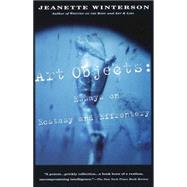
Note: Supplemental materials are not guaranteed with Rental or Used book purchases.
Purchase Benefits
What is included with this book?
| Art Objects | p. 3 |
| Trasformation | |
| Writer, Reader, Words | p. 25 |
| Testimony Against Gertrude Stein | p. 45 |
| A Gift of Wings (with reference to Orlando) | p. 61 |
| A Veil of Words (with reference to The Waves) | p. 79 |
| Ecstacy and Energy | |
| The Semiotics of Sex | p. 103 |
| The Psychometry of Books | p. 119 |
| Imagination and Reality | p. 133 |
| Art and Life | p. 153 |
| A Work of My Own | p. 165 |
| Table of Contents provided by Blackwell. All Rights Reserved. |
The New copy of this book will include any supplemental materials advertised. Please check the title of the book to determine if it should include any access cards, study guides, lab manuals, CDs, etc.
The Used, Rental and eBook copies of this book are not guaranteed to include any supplemental materials. Typically, only the book itself is included. This is true even if the title states it includes any access cards, study guides, lab manuals, CDs, etc.
Excerpted from Art Objects: Essays on Ecstasy and Effrontery by Jeanette Winterson
All rights reserved by the original copyright owners. Excerpts are provided for display purposes only and may not be reproduced, reprinted or distributed without the written permission of the publisher.